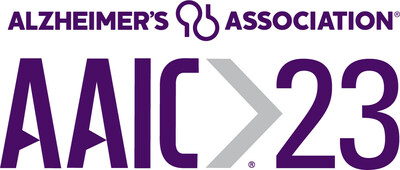Two new CRISPR-based therapeutic approaches for Alzheimer’s were reported at the Alzheimer’s Association International Conference® 2023, in Amsterdam, Netherlands, and online.
Key Takeaways:
- Two new CRISPR-based strategies offer hope for next-generation Alzheimer’s treatments.
- One seeks to dampen the impact of the most common Alzheimer’s risk gene; the other aims to decrease production of a toxic protein in the brain.
AMSTERDAM, July 16, 2023 /PRNewswire/ -- Two new CRISPR-based therapeutic approaches for Alzheimer‘s were reported today at the Alzheimer’s Association International Conference® (AAIC®) 2023, in Amsterdam, Netherlands, and online. One aims to reduce the impact of the strongest known Alzheimer’s risk gene, APOE-e4. The other strives to reduce production of a toxic protein in the brain, beta amyloid, which is a hallmark of Alzheimer’s disease and the target of recently-approved treatments.
Gene editing using the Clustered Regularly Interspaced Short Palindromic Repeats system, known as CRISPR, is emerging as one of the most powerful tools in the search for new drugs. CRISPR technology is, among other things, making drug target identification faster with the goal of speeding up the drug discovery process, and building platforms for the development of next-generation treatments. This last point is the focus of the new reports at AAIC 2023.
“A pipeline of potential new treatments offers hope for the Alzheimer’s and dementia community,” said Maria C. Carrillo, Ph.D., Alzheimer’s Association chief science officer. “The progress and approvals we’ve seen, as well as the diversification of potential new therapies over the past few years, provides hope to those impacted by this devastating disease. The anti-amyloid drugs newly approved by the U.S. Food and Drug Administration are an important first step in Alzheimer’s treatment, but there is so much more to be done.”
“Studies such as these two that focus the most advanced technologies — in this case, CRISPR — on moving Alzheimer’s treatment and prevention forward are enthusiastically welcomed, and need to be multiplied many times over,” Carrillo said. “We envision a future where multiple treatments address every aspect of this most complex disease. And that, once proven, the treatments can be combined in ways that complement and enhance each other to reduce risk, treat effectively, stop the progression and eventually cure Alzheimer’s disease and all other dementia.”
CRISPR Treatment Reduces Production of Amyloid Beta in Mice
Brent Aulston, Ph.D., and colleagues in the Subhojit Roy lab at University of California San Diego, have developed a gene-editing strategy that targets the amyloid precursor protein (APP), which Aulston calls “a gene with a central and indisputable role” in Alzheimer’s. Depending on how it is cut by various enzymes in the brain, APP can create products that are either protective (sAPPa) or pathologic (beta amyloid). Aulston’s approach hopes to reduce the production of beta amyloid while increasing neuroprotective actions.
Testing the process in an Alzheimer’s disease mouse model, the researchers found that CRISPR-treatment led to reduction of beta amyloid plaques and associated markers of brain inflammation, an increase in neuroprotective APP products, and correction of behavioral and nervous system function deficits. In addition, CRISPR-editing did not lead to undesirable side effects in normal mice.
“We believe this demonstrates that, in mice, our potential treatment strategy is both safe and efficacious,” Aulston said. “These results justify future studies aimed at getting APP CRISPR editing into human testing.”
CRISPR’s Potential to Lower Levels of an Alzheimer’s Risk Gene
Certain genes can increase the risk of developing dementia, including Alzheimer’s disease. One of the most significant genetic risk factors for some populations is called APOE-e4, although inheriting this gene does not guarantee that a person will develop the disease. Having one copy of APOE-e4 increases the risk of developing Alzheimer’s two- to threefold. Having two APOE-e4 genes increases risk even more: approximately eight- to twelvefold.
Boris Kantor, Ph.D., associate professor of neurobiology and faculty member at the Center for Advanced Genomic Technologies at Duke University, Ornit Chiba-Falek, Ph.D., professor in neurology and division chief of translational brain sciences, and colleagues described an epigenome therapy platform based on CRISPR/dCas9-editing strategy intended to reduce APOE-e4. The scientists found that their lead candidate can robustly reduce the levels of APOE-e4 in both human induced pluripotent stem cell derived miniature brains from an Alzheimer’s patient and humanized mouse models, without changing levels of other APOE variants that are thought to be neutral or protective.
“The findings are incredibly exciting,” Kantor said. “They provide proof-of-concept evidence supporting our approach as a high potential new strategy to treat and possibly even prevent Alzheimer’s disease, which currently has no cure.”
“The goal of our therapeutic strategy is to advance the field of Alzheimer’s drug discovery towards precision medicine,” Chiba-Falek added. “We believe the results are very promising and support moving forward with IND-enabling studies.”
About the Alzheimer’s Association International Conference® (AAIC®)
The Alzheimer’s Association International Conference (AAIC) is the world’s largest gathering of researchers from around the world focused on Alzheimer’s and other dementias. As a part of the Alzheimer’s Association’s research program, AAIC serves as a catalyst for generating new knowledge about dementia and fostering a vital, collegial research community.
AAIC 2023 home page: www.alz.org/aaic/
AAIC 2023 newsroom: www.alz.org/aaic/pressroom.asp
AAIC 2023 hashtag: #AAIC23
About the Alzheimer’s Association®
The Alzheimer’s Association is a worldwide voluntary health organization dedicated to Alzheimer’s care, support and research. Our mission is to lead the way to end Alzheimer’s and all other dementia — by accelerating global research, driving risk reduction and early detection, and maximizing quality care and support. Our vision is a world without Alzheimer’s and all other dementia®. Visit alz.org or call 800.272.3900.
- Brent D. Aulston, Ph.D., et al. In vivo safety and efficacy of a CRISPR-based gene therapy for Alzheimer’s disease. (Funders: Alzheimer’s Association, Epstein Foundation, U.S. National Institutes of Health)
- Boris Kantor, Ph.D., et al. APOE-targeted epigenome therapy for late onset Alzheimer’s disease. (Funder: U.S. National Institute on Aging - R41 AG077992-01)
*** AAIC 2023 news releases may contain updated data that does not match what is reported in the following abstracts.
![]() View original content to download multimedia:https://www.prnewswire.com/news-releases/crisprgene-editing-technology-creates-new-treatment-possibilities-for-alzheimers-disease-301878066.html
View original content to download multimedia:https://www.prnewswire.com/news-releases/crisprgene-editing-technology-creates-new-treatment-possibilities-for-alzheimers-disease-301878066.html
SOURCE Alzheimer’s Association





